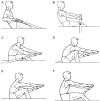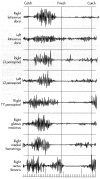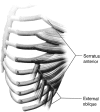Rowing injuries
- PMID: 23016093
- PMCID: PMC3435926
- DOI: 10.1177/1941738112442484
Rowing injuries
Abstract
Context: Rowing is one of the original modern Olympic sports and was one of the most popular spectator sports in the United States. Its popularity has been increasing since the enactment of Title IX. The injury patterns in this sport are unique because of the stress applied during the rowing stroke.
Evidence acquisition: This review summarizes the existing literature describing the biomechanics of the rowing stroke and rowing-related injury patterns. Data were obtained from previously published peer-reviewed literature through a search of the entire PubMed database (up to December, 2011) as well as from textbook chapters and rowing coaching manuals.
Results: Rowing injuries are primarily overuse related. The knee, lumbar spine, and ribs are most commonly affected. The injury incidence is directly related to the volume of training and technique.
Conclusion: Familiarity of the injury patterns and the biomechanical forces affecting the rowing athlete will aid in prompt diagnosis and appropriate management.
Keywords: lumbar degenerative disc disease; overuse injuries; rib stress fractures; rowing; rowing injuries.
Figures

















References
-
- Adams MA, Dolan P. Recent advances in lumbar spinal mechanics and their clinical significance. Clin Biomech (Bristol, Avon). 1995;10(1):3-19 - PubMed
-
- Boland A, Hosea T. Rowing and sculling and the older athlete. Clin Sports Med. 1991;10(2):245. - PubMed
-
- Caldwell JS, McNair PJ, Williams M. The effects of repetitive motion on lumbar flexion and erector spinal muscle activity in rowers. Clin Biomech (Bristol, Avon). 2003;18(8):704 - PubMed
-
- Hannafin J, Hosea T. Oar sports. In: Garret WE, Kirkendall DT, Squire DL, eds. Principles and Practice of Primary Care Sports Medicine. Philadelphia, PA: Lippincott, Williams & Wilkins; 2001:531-540
-
- Holden D, Jackson D. Stress fractures of the ribs in female rowers. Am J Sports Med. 1985;13(5):342. - PubMed
LinkOut - more resources
Full Text Sources

